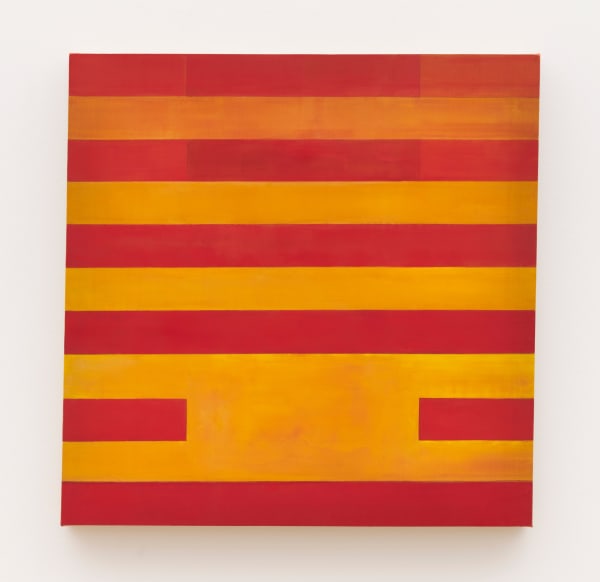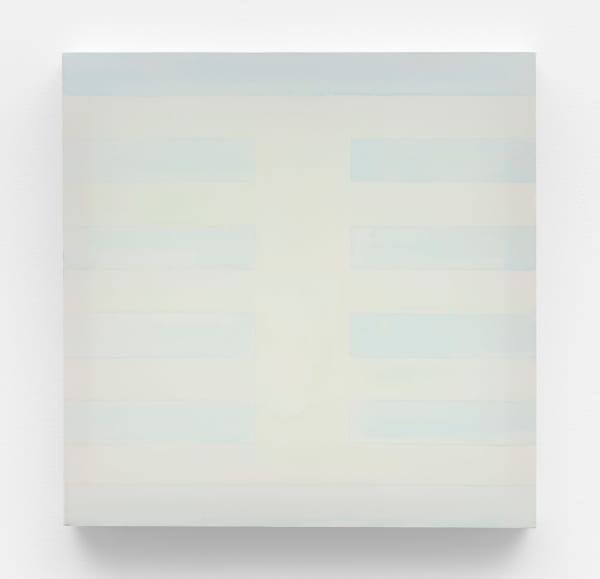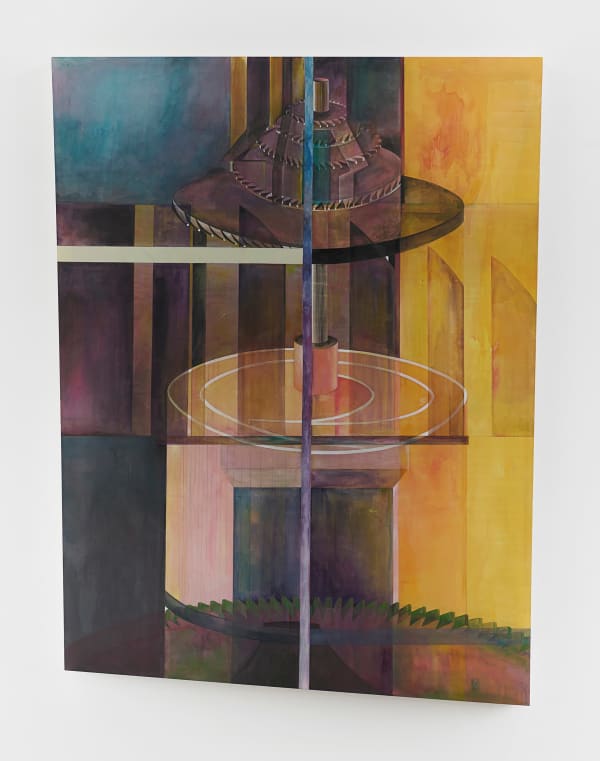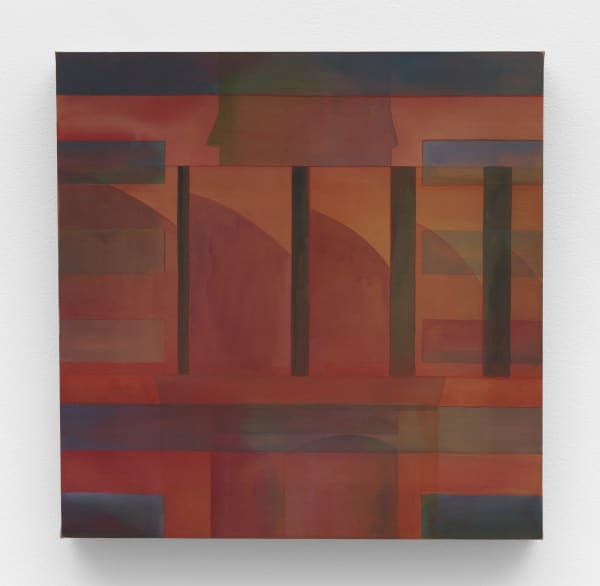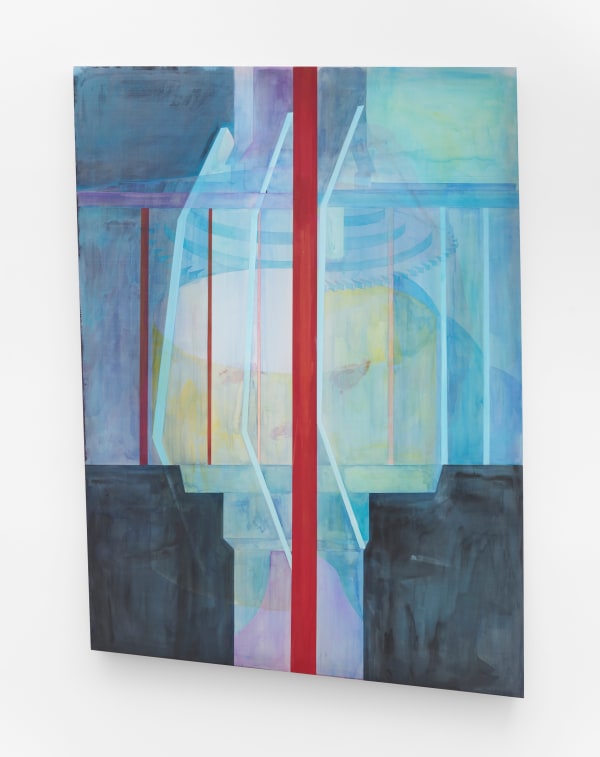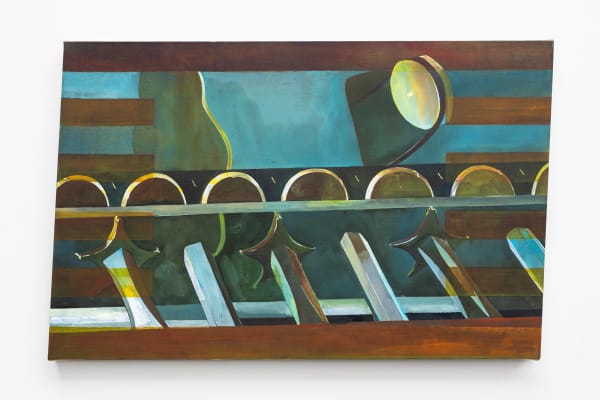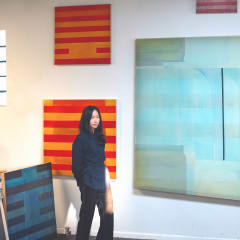I-Ching / Machine Leah Ke Yi Zheng
A Mendes Wood DM tem o prazer de anunciar a segunda exposição individual de Leah Ke Yi Zheng com a galeria, após o anúncio de representação da artista nascida na China e baseada em Chicago.
A exposição ocupa tanto o térreo quanto o espaço subterrâneo da galeria no Tribeca e é constituída por 12 novas obras pintadas em sedas esticadas sobre armações de madeira natural. Cada pintura, em graus variados, se desvia do ortogonal para alcançar formas extraordinárias e irregulares. Além disso, Zheng apresenta um vídeo pintado à mão na exposição.
O térreo da galeria se dedica à representação dos hexagramas do I-Ching: cada quadro corresponde a um aspecto diferente de nosso universo, como o poder, a limitação, a clareza ou o equilíbrio. O subterrâneo enfatiza a exploração contínua da artista de engrenagens de máquinas e aparatos matemáticos, que refletem uma meditação sobre a vida moderna e a representabilidade do tempo. Pela primeira vez na carreira da artista, algumas dessas peças unem os temas, com hexagramas do I-Ching sobrepostos sobre imagens de máquinas. É no subterrâneo, inclusive, que um exemplo desse novo aspecto é visto suspenso, a luz trespassando a seda, tanto a frente quanto o verso da obra visíveis.
A exposição explora uma negociação contínua entre a educação e a criação inicial de Zheng, ligadas à paisagem natural e às técnicas de pintura chinesas, e as histórias das vanguardas ocidentais estudadas por ela na Escola do Instituto de Arte de Chicago.
Um ensaio escrito por A. E. Benenson acompanha a exposição.
Arrumar e organizar a profusão inacabada desses momentos de início exatamente como quem separa os fios de seda de um nó emaranhado e os enlaça em meadas.
Willhelm-Baynes no Hexagrama do I-Ching #3: Dificuldade no começo
Os nós das pinturas de seda de Leah Ke Yi Zheng são do tipo que, toda vez que você os puxa, tentando soltá-los, ficam cada vez mais tensos. Quando você sabe só um pouco – a mente afrouxada –, eles parecem suficientemente simples: alguns têm barras horizontais que se repetem, como um Stella ou um LeWitt lanoso. Linha, linha, linha. Palermo, Kelly, Buren. Quando você se aproxima e os puxa com um pouco mais de força, as coisas ficam um pouco mais complicadas. Funciona um pouco como a mágica que chamam de close-up: os detalhes extraordinários desses quadros se multiplicam à medida que você chega perto deles. Linhas aparentemente sólidas se mostram riscadas por rasgos de nafta e cobalto, dissipados por uma camada de céladon marinho ou uma névoa noturna da terra de siena; manchas de ocre florescem; surge uma bruma de pontos aqui e ali, como se o acrílico que os forma tivesse sido exalado, em vez de pintado. Há muitos efeitos a serem notados na superfície, e então, nas bordas, o delineado das talas de madeira aparece, ossos sob a pele tesa. Dessa maneira, o solo de seda não se trata de um solo na verdade, mas talvez uma rede que captura o que pode ou um véu que cobre confissões. As listras sobre as superfícies estão mais próximas da transcrição do que da geometria: cada conjunto é um dos 64 textos proféticos do I-Ching. Uma linha interrompida sobre cinco linhas ininterruptas vem do #43 (Ruptura), um pictograma de um lago sob um céu rompido e um feitiço usado para superar um bloqueio criativo:
Deve-se dar a conhecer o assunto
na corte do rei com determinação.
Deve ser exposto com veracidade. Perigo.
É necessário notificar a própria cidade.
Não é favorável recorrer às armas.
É favorável empreender algo.
É difícil não pensar em Melencolia I (1513), de Dürer, um criptograma que ainda hoje nos intriga. Na obra, o artista, no seu limite, é representado como uma dama alada, queixo apoiado no punho, rodeada por uma porção de ferramentas descartadas e símbolos esotéricos. As pinturas de Zheng pertencem à mesma tradição, a chamada vexierbild, “imagens quebra-cabeça” que transbordam com segredos, figuras como engrenagens planas que pedem para ser giradas pelas rodas de nossas mentes. Ao longo de 500 anos os observadores tentaram compreender o significado exato de tudo que Dürer incluiu nessa gravura, de modo a chegar ao fundo dela. Foi o historiador da arte J. L. Koerner que apontou que não havia um fundo ali, que Dürer havia propositalmente sobrecarregado a imagem com significados múltiplos e contraditórios para que o assunto e o observador se unissem para sempre em vexação.
De maneira semelhante, nos trabalhos de Zheng, não há exatamente um código a ser decifrado, e sim um botão a ser acionado. Cada leitura do I-Ching, em primeiro lugar, não é uma conclusão, mas uma espécie de dispositivo, uma mola em forma de esfinge bem apertada. Suas linhas – que, em conjuntos de seis, correspondem a uma estrofe profética – são calculadas a partir de três jogadas de moeda cujas combinações específicas carregam a leitura com uma espécie de gatilho muito delicado, capaz de inverter seus significados. Toda a pilha veicula não apenas sua mensagem enigmática, mas também uma força precária e tensa: uma arquitetura de associações ziguezagueantes que representam as forças em fluxo que supostamente animam o universo.
Por alguns anos, Zheng também voltou às representações da fusée, uma engrenagem especializada inventada no século XVI para regular o desbobinar errático das molas dos mecanismos de relógios. Nessa exposição, ela justapos os fusées às leituras do I-Ching, afiando seus contrastes com outro Koan [um paradoxo zen-budista] do processo da artista: um zumbido místico regulado dentro de um tique-taque oficioso. A arte deve vir de um além autêntico, e ninguém é capaz de dizer quando as musas vão cantar, mas, você sabe, tempo é dinheiro. Em outro ponto, Zheng faz o desenho de um computador mecânico primitivo projetado por Leibniz para agilizar trabalhos contábeis. Bem, até os antigos ficaram cansados de esperar os bichos-da-seda acabar de tecer seus casulos macios, então os artesãos ferviam as larvas enquanto elas ainda dormiam.
O uso que Zheng faz do I-Ching é labiríntico, e a aparência do hexagrama é confundida desde várias direções em suas pinturas. Suas superfícies de seda, como teias, traem o fato de que sua ilusão está na habilidade continuar a acrescentar camada após camada, material e metaforicamente. Tudo parece dançar naquela superfície límpida; ao remover uma da parede, a tela se torna tão fina que até a luz passa sem obstáculos. E, ainda assim, como Koerner disse em relação a Melencolia I, não há como chegar ao fundo.
É um caso bastante diferente da primeira aparição novidadeira do I-Ching na arte ocidental (nas mãos, no geral, de artistas brancos e masculinos). John Cage, Merce Cunningham, Philip K. Dick... eles pediram ao livro que fizesse decisões quanto às suas obras, mas os trabalhos resultantes eram como montes de garrafas vazias, abandonadas após uma bebedeira autocentrada. As pinturas de Zheng, em oposição, não se preocupam com a produção de decisões ou resultados. Se elas de fato têm um aspecto temporal, é o agora palpável, tremeluzente e perpétuo desse achatamento de inúmeras camadas. Pinceladas, matizes, armações, alusões ao cânone, profecias... cada uma das pinturas de Zheng é como a pilha de itens esotéricos jogados na base de Melencolia. Nesse contexto, o solo de seda é sublimado num suporte metafísico – o forro do presente, aquele momento delicado de atenção que avança sobre nós de uma vez só e intuitivamente.
Pergunte a Jung, em vez de a Greenberg, sobre essa espécie peculiar de achatamento: o psicólogo era fascinado pela imanência proposta pelo I-Ching, pelo modo como seus métodos produziam um instantâneo de textura rica de casualidade que é tudo menos aleatória, refletindo a “interdependência peculiar” de eventos aparentemente sem relação. Para o pensamento ocidental (e, acrescentemos, a arte ocidental), que era preocupada com cadeias determinísticas de causa e efeito, o I-Ching produzia “uma imagem do momento que abrange tudo, até o mínimo detalhe mais sem sentido”. Jung chamou essa imagem de metafísica do livro de sincronicidade, uma insistência na densidade irredutível da experiência. Em uma palavra, seria a forma e o conteúdo do vexierbild de Zheng. E o resultado é um modo inteiramente diferente de ler o aspecto achatado da imagem pintada: como as coordenadas da compressão definitiva de todo o nosso fazer e ver em um único plano sem dimensões, como a pressão insondável no centro de um buraco negro. Aqui se vê a honestidade material do Modernismo sem sua arrogância exangue. Um achatamento vexativo como aquela versão cósmica que dizem ser capaz de abarcar não apenas isso ou aquilo, mas absolutamente tudo.
A.E. Benenson, January 2025
Leah Ke Yi Zheng (1988, Wuyishan, China) vive e mora em Chicago.
Suas exposições individuais e duos recentes incluem I-Ching/Machine, Mendes Wood DM, Nova York, EUA (2025); Leah Ke Yi Zheng, Mendes Wood DM, Bruxelas, Bélgica; John Cage & Leah Ke Yi Zheng, CASTLE, Los Angeles, EUA (2024); Leah Ke Yi Zheng, David Lewis, Nova York, EUA; Leah Ke Yi Zheng & Dany Bredar, Arts Club of Chicago, Chicago, EUA (2022). Exposições coletivas recentes incluem Everyone Loves Picabia, David Lewis, Nova York, EUA (2024) e Soul Mapping, Zeno X Gallery, Antuérpia, Bélgica (2023).
-
 Leah Ke Yi Zheng, no.55 <-> no.49 <-> no.13 <-> no.30, 2024
Leah Ke Yi Zheng, no.55 <-> no.49 <-> no.13 <-> no.30, 2024 -
 Leah Ke Yi Zheng, Untitled (no.49/revolution), 2024
Leah Ke Yi Zheng, Untitled (no.49/revolution), 2024 -
 Leah Ke Yi Zheng, no.63 <-> no.37 <-> no.13 <-> no.49 <-> no.43 <-> no.1 <-> no.9 <-> no.5 <-> no.34, 2024
Leah Ke Yi Zheng, no.63 <-> no.37 <-> no.13 <-> no.49 <-> no.43 <-> no.1 <-> no.9 <-> no.5 <-> no.34, 2024 -
 Leah Ke Yi Zheng, no.60, 2024
Leah Ke Yi Zheng, no.60, 2024 -
 Leah Ke Yi Zheng, no.27, 2024
Leah Ke Yi Zheng, no.27, 2024 -
 Leah Ke Yi Zheng, no.64 <-> no.6 <-> no.50 <-> no.44 <-> no.14 <-> no.1, 2024
Leah Ke Yi Zheng, no.64 <-> no.6 <-> no.50 <-> no.44 <-> no.14 <-> no.1, 2024 -
 Leah Ke Yi Zheng, no. 42, 2024
Leah Ke Yi Zheng, no. 42, 2024 -
 Leah Ke Yi Zheng, no. 64, 2024
Leah Ke Yi Zheng, no. 64, 2024 -
 Leah Ke Yi Zheng, Machines, 2024
Leah Ke Yi Zheng, Machines, 2024 -
 Leah Ke Yi Zheng, no. 4, 2024
Leah Ke Yi Zheng, no. 4, 2024 -
 Leah Ke Yi Zheng, Untitled (spinning machine), 2024
Leah Ke Yi Zheng, Untitled (spinning machine), 2024 -
 Leah Ke Yi Zheng, Untitled (no. 27 / Leibniz's machine), 2024
Leah Ke Yi Zheng, Untitled (no. 27 / Leibniz's machine), 2024 -
 Leah Ke Yi Zheng, I-Ching 64, 2024-2025
Leah Ke Yi Zheng, I-Ching 64, 2024-2025

